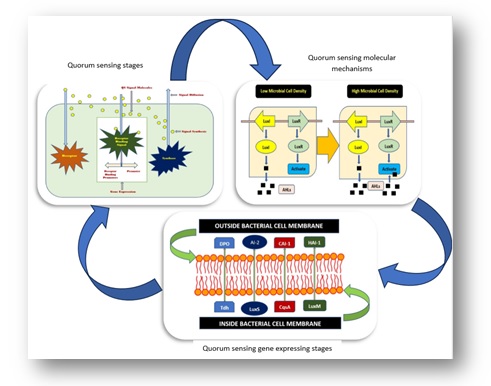Document Type : SPECIAL ISSUE
Authors
1 Amity Institute of Horticulture Studies and Research, Amity University Uttar Pradesh, India
2 Department of Agricultural Engineering, Kalasalingam Academy of Research and Education, Krishankoil, Srivilliputhur, Tamil Nadu, India
3 Department of Environmental Health Engineering, Tehran University of Medical Sciences, Tehran, Iran
Abstract
Microorganisms are present in nature and shape an enormous a half of our micro- and macro-environment. Quorum sensing is the process of intercellular conversation that enables microbes to perceive their surroundings and change their behaviour, allowing them to remain like cellular organisms. Both Gram-positive and Gram-negative microorganisms use quorum sensing frame work for communicating with every other, though there may be distinct quorum sensing pathways available in Gram-positive and Gram-negative microorganisms. The scope of quorum sensing extends to inter-nation communication, mediate through numerous newly diagnosed extra-cell signal molecules known as autoinducers. The concentration of these signalling substances rises above a critical level when the population density does, causing particular gene expression patterns in the microorganisms. This may result in coordinated behaviours, including the development of biofilms, the generation of virulence factors, or other group activities. Without the ability to detect and react to the presence of their neighbours, microbial communities would not be able to adjust to changing environmental conditions or carry out collective actions that are essential for survival. Among those autoinducers, five major principal signal molecules are perturbed about side the classical quorum sensing system. The larger part of quorum sensing recognizing inhibitor takes bacterial quorum sensing share identifying as the even-handed and simply blocks the larger part recognizing plan of pathogenic organisms, which can demolish the pathogenicity of microorganisms without applying explicit squeezing factor, and doesn't execute the regular organisms or then again intrude with their standard physiological activities. To talk with each other, bacteria mix, release, and total minimal diffusible signal molecules, known as pheromones or autoinducers a pheromone (recognizing) depends upon its edge centre. Specific receptors found on the surface of the bacterial cell are required for the identification of pheromones or autoinducers. The proteins that can bind to diffusible signalling molecules often make up these receptors. These receptors bind to signalling molecules when their concentration rises over a predetermined threshold, setting off a signalling cascade that causes the bacteria to respond in concert. The prevailing article will speak about checking out basic variations between numerous quorum sensing systems in gram passitive and gram negative bacteria, and it is important to understand the communications of microorganisms in nature better. QS sensing will help as a regular language for signal communication of various microorganisms, yet the path where all proteins get the signals and turn on downstream sign transduction has changed phenomenally.
Graphical Abstract
Keywords
Main Subjects
OPEN ACCESS
©2023 The author(s). This article is licensed under a Creative Commons Attribution 4.0 International License, which permits use, sharing, adaptation, distribution and reproduction in any medium or format, as long as you give appropriate credit to the original author(s) and the source, provide a link to the Creative Commons license, and indicate if changes were made. The images or other third party material in this article are included in the article’s Creative Commons license, unless indicated otherwise in a credit line to the material. If material is not included in the article’s Creative Commons license and your intended use is not permitted by statutory regulation or exceeds the permitted use, you will need to obtain permission directly from the copyright holder. To view a copy of this license, visit: http://creativecommons.org/licenses/by/4.0/
PUBLISHER NOTE
GJESM Publisher remains neutral concerning jurisdictional claims in published maps and institutional affiliations.
CITATION METRICS & CAPTURES
Google Scholar | Scopus | Web of Science | PlumX Metrics | Altmetrics | Mendeley |
CURRENT PUBLISHER
GJESM Publisher



Letters to Editor
[1] Letters that include statements of statistics, facts, research, or theories should include appropriate references, although more than three are discouraged.
[2] Letters that are personal attacks on an author rather than thoughtful criticism of the author’s ideas will not be considered for publication.
[3] Letters can be no more than 300 words in length.
[4] Letter writers should include a statement at the beginning of the letter stating that it is being submitted either for publication or not.
[5] Anonymous letters will not be considered.
[6] Letter writers must include their city and state of residence or work.
[7] Letters will be edited for clarity and length.
Send comment about this article